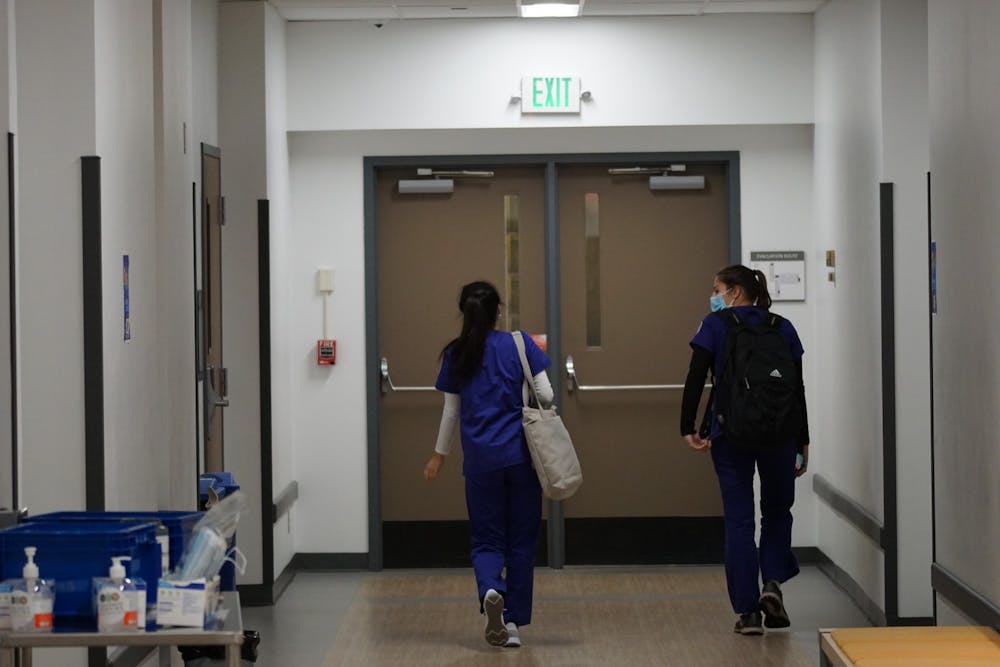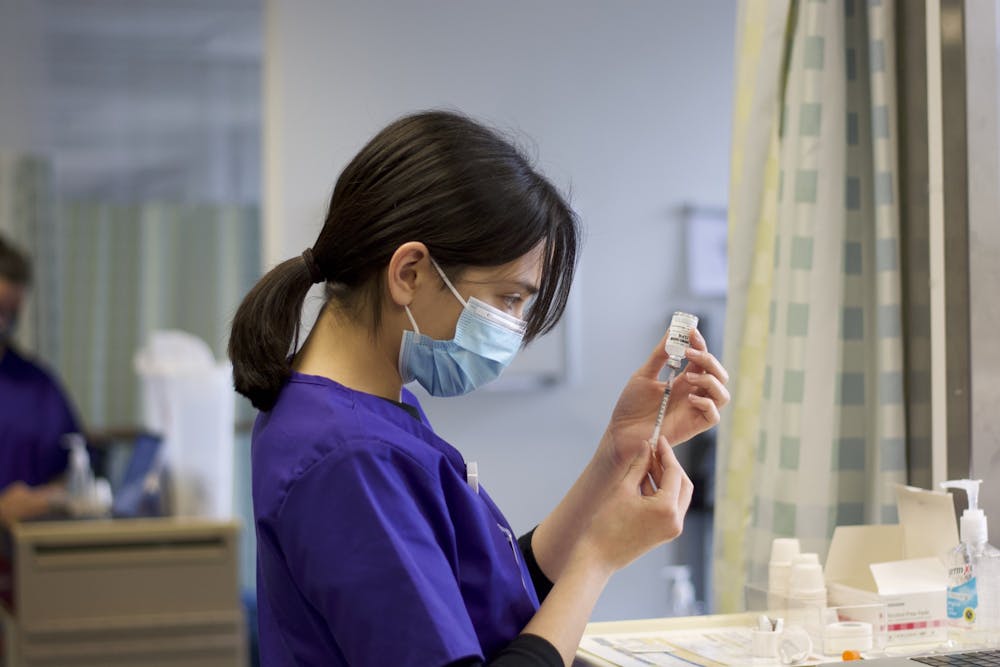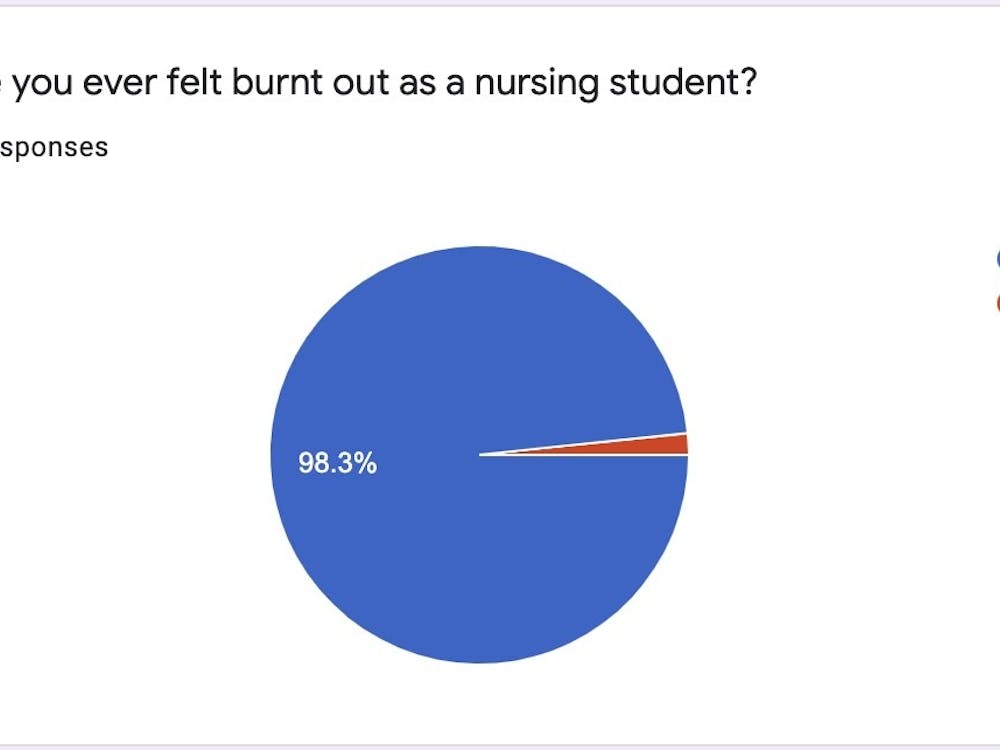When the senior class of nursing students began the program in 2019, they didn’t expect their time in nursing school to coincide with a world-wide pandemic. But, since then, the landscape of healthcare changed as we know it, and that still seems to be the case.
The COVID-19 pandemic saw an uptick in hospitalizations as well as burnout in healthcare workers — leaving many hospitals across the United States short-staffed. For nursing students, the crisis has its benefits, but that doesn't minimize the negatives.
For starters, the nationwide shortage of nurses means an almost guaranteed job following graduation. However, this same shortage means students and faculty alike must confront one of the largest issues facing nursing schools today: Hospitals and other health care institutions are no longer providing as many opportunities for nursing students to train in clinical settings.
To combat this, the School of Nursing and Health Innovations (SOHNI) has developed various methods for students to complete their schooling and prepare for the National Council Licensure Examination (NCLEX) through developing a new simulation track for student clinicals as well as looking towards nursing internships for students.
In a meeting between nursing students and nursing faculty last semester, it was announced that there would be two different tracks for seniors in the nursing school: simulation track and clinical track.
Simulation track and clinical track
With one of UP’s largest draws of student enrollment being the UP School of Nursing’s accredited program, the decision for half of the senior class to conduct clinicals in simulation was not an easy one, but it was necessary. Yet, Dean of SOHNI Casey Shillam is confident in the experience the Simulation Lab brings to students.
“[Simulation Lab] is going to prepare you for practice,” Shillam said. “It's going to make sure you know that you are going to pass your licensure exam and you're going to be prepared for practice.”
The two clinical tracks differ heavily and are not entirely up to the student to decide which they are placed in. The clinical track has students attend an on-site clinical-site for six hours on either Tuesdays or Thursdays shadowing nurses and floating on floors in their respective sites. In comparison, the simulation track involves students attending the on-campus simulation lab and completing a variety of assignments that is intended to equal the amount of hours that clinical track students spend in hospitals.

UP’s simulation lab involves actors alongside mannequins who come in to act as patients for the nursing students to practice on.
“I firmly believe that our standardized patient actors make an incredible difference,” Shillam said. “We are the only accredited simulation program in the entire state of Oregon.”
While students cannot request that they be put on a clinical track, they are able to request being put on the simulation track.
Senior nursing student Sam Pettinato is one of the students who chose to be on the simulation lab track — citing convenience and flexibility as his main reasons for this choice.
“Looking at things that I wanted to do this semester I just knew that this track would allow me to have a more flexible schedule and that was really nice to me,” Pettinato said.
Alternatively, Kareen Nguyen, also class of ‘23, was placed in the Simulation lab track despite hoping for a clinical placement.
Being on a full sim track, Nguyen expressed how difficult it can be to suspend her disbelief that the simulation is just that, a simulation.
“You're like, ‘this is not real, this feels so fake.’” Nguyen said. “I know it's fake, so all of it just seems fake.”
Standardized patient actors don't have the symptoms, complications or disorders that the students are practicing to treat or learning to notice. Instead the actors are instructed to tell the students what their feigned diagnoses are so the student can respond.

To Nguyen, she feels as though the way the simulation labs work doesn’t always simulate the skills she would need had it been a real hospital setting.
“In sim you just pretend that you're listening to their heart or like their lung sounds,” Nguyen said. “It's fake. They just give you a card that says they have diminished crackles. [...] When I go in the real world and practice I can actually listen to crackle sound, but with sim how can I defer what I’m listening to?”
However, this is not the perspective of all students. Pettinato sees the simulation lab as a good match for being in a clinical placement, as well as it having additional benefits. He describes his first supplemental Simulation lab in which they practiced a code blue — which indicates that a patient requires revival.
“We had to start doing compressions, CPR, all of that,” Pettinato said. “And that's something that if I was at an off campus clinical and our patient coded I would have to stand in the back of the room and watch the nurses whereas in sim, I get to lead that.”
While there are differing opinions from students on the effectiveness of the simulation track, Shilliam believes it is the best course of action considering the state of healthcare in Oregon.
“There is value absolutely in having off campus experience which is why we ensured every student has had off campus experience right at some point over their entire nursing curriculum,” Shillam said. “It's just, at this point, not everyone is getting an individualized precepted experience.”
House Bill 4003
In addition to making the shift to half simulation lab clinicals, Shillam has been working on the funding to implement House Bill 4003: a bill passed in March of 2022 that allows Oregon hospitals to hire undergraduate nursing students as paid interns in which they would also receive academic credit.
“I've been working on the legislation to help with getting funding to help support people to be able to hire,” Shillam said. “And not just to hire but to reposition and rethink what we're doing with students.”
Right now, there are eight students who are in this nursing intern program.
“This spring we are piloting a program where we are figuring out ‘how does this all work?’” Shillam said. “This is how we're going to solve this problem. It isn't about going back to the old way of doing things — it's us having to figure out ‘how do we do things differently?’”
Shillam, alongside the rest of the Oregon Health Authority’s Task Force, made recommendations to the Oregon Legislature in November of 2022 where they determined there was a lack of clinical placements across Oregon as a whole.
Shillam identifies the two variables that contribute to this issue as being the significant drop in nursing staff and the higher bed occupancy in Portland hospitals.
“In the midst of the pandemic and in the last year, right when we had the waves of Omicron and Delta, it really exhausted and depleted nurses,” Shillam said. “They were completely burnt out so anyone who was within five to 10 years of retirement, they left.”
Reporting from The Oregonian covered the nurse burnout happening across the state as well as the reasons for why there is a decrease in clinical placements and nursing faculty in general.

Additionally, Multnomah County bed occupancy data shows an average of 91.2% occupancy rate inpatient beds and 86.3% for beds in the intensive care units within the greater Portland at time of publication, not including specialty and childrens hospitals. For reference, the nationwide average hospital bed occupancy rate in 2015 was 65.5% as reported by the CDC.
These higher-than-normal percentages are partly unsurprising given Oregon’s background. Back in 2021 in the midst of the pandemic, KGW reported Oregon as having the fewest hospital beds per capita in the United States.
“It's not just UP,” Shillam said. “It's every school in the Portland metro area, schools across the state, schools across the entire country.”
With Oregon Hospitals still in high capacity and short of staff, the University of Portland is keeping their options open to remaining in the partial simulation-only and partial off-campus clinical set-up that they have now.
While this was UP’s way of combating the decrease in available clinical placements, it can be easy for students to grow frustrated with SNHI when not given a track they were expecting when deciding on a University.
“I feel unprepared,” Nguyen said. “I feel like I won't be able to get a job because I have no experience. The only hospital experience I had was six days total of four years here.”
Pettinato urges students to consider the whole situation in scenarios like this.
“I think my class has a lot of anger towards the faculty members because they only had enough clinical spots for 50% of our class,” Pettinato said. “Don't be upset at our faculty, there's good people, they try so hard — it's just uncontrollable factors that are leading to us right now not having a lot of clinical spots.”
Shillam echoes this claim, praising the nursing faculty on how they’ve navigated the past few years during and following the COVID-19 pandemic.
“I really hope that our students can feel and know that the faculty care about them so deeply and they have worked more hours and more in more challenging situations than I can even count in the last three years,” Shillam said. “They care so deeply about our students and they are the reason we're here.”
Kate Cuadrado is the News and Managing Editor for The Beacon. She can be reached at cuadrado24@up.edu.








